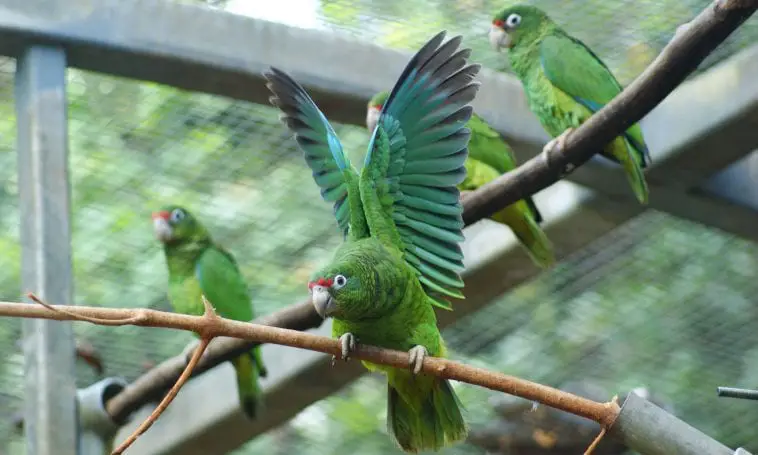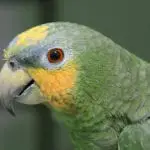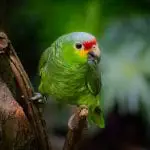Scientific Facts
| Common Name | Puerto Rican Amazon |
| Scientific Name | Amazona vittata |
| Lifespan | 50 Years |
| Size | 11.3 inches (29cm) |
| Body Mass | 11.2oz. (320grams) |
| Habitat | Terrestrial; Tropical rainforests |
| Range | Island of Puerto Rico |
Information & Physical Appearance

The Puerto Rican Amazon (Amazona vittata) is a member of the order Psittaciformes, the family Psittacidae, the genus Amazona.
Other common names include Puerto Rican Parrot, Red-fronted Amazon, and Red-fronted Parrot.
There used to be two recognized subspecies, namely A.v.vittata (nominate race) and A.v.gracilipes.
A.v.gracilipes used to inhabit Culebra Island.
However, the subspecies gracilipes is now extinct. There is no clear evidence of the extinct gracilipes subspecies being substantially different from the nominate race, except for both sexes of adult gracilipes measuring smaller in size, and characterized by more slender feet, as compared with A.v.vittata adults.
Puerto Rican Amazons are not sexually dimorphic; hence, one cannot tell the difference between an adult male and an adult female at a glance.
Both sexes display mostly green coloring on the majority of the body.
There is a red forecrown located between the eyes, the beak, and the primaries, with the latter displaying two-toned blue coloration.
Yellow coloring is visible on the underparts, and the feathers are edged in nuances of soft black. Because of almost all feathers being tipped with black, these birds have a scaly look.
The legs are soft pink to flesh-colored. The bill is mellow horn/yellow in color. The tail is green, and the tail’s base is red.
Eyes are brown, and there is a white eye-ring.
Juveniles
Juveniles closely resemble adults, with the major exception that the juveniles’ bills are pale yellow with the upper mandible displaying grey tones at the base.
Lifespan
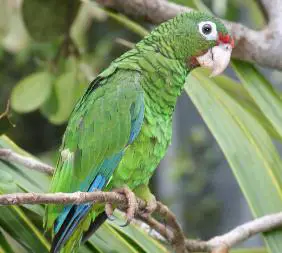
Up-to-date, solid evidence regarding the lifespan and longevity of the Puerto Rican Amazon is still lacking.
However, according to experts, the lifespan of Amazona vittata is very closely related to the lifespan of Amazon leucocephala (the Cuban Amazon) in general. Therefore, Puerto Rican Parrots are believed to possibly live for up to 50 years.
The generation length is estimated at 12.3 years.
Ecosystem & Habitat
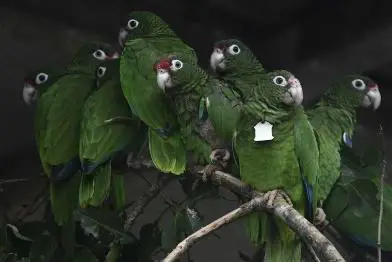
HABITAT
Back in time, Puerto Rican Amazons used to be found all across Puerto Rico, in all vegetation types, except for the dry forest located in the southern parts of the Island of Puerto Rico.
Generally, the preferred types of habitat include mangrove and montane forests.
Once abundant in the Quebradillas, Arecibo, Isabella, and Utaudo mangroves areas, nowadays, these parrots can be only found in the northern portion of the island, more specifically, in the Luquillo Forest along Route 191.
The remnant population is confined to the moist montane forests. These parrots are found at elevations of up to 1968ft. (600 meters).
RANGE
Puerto Rican amazons’s range encompasses the West Indies on the Greater Antilles island of Puerto Rico. These unique parrots are only found in the northern parts of Puerto Rico, and in Culebra and Mona (formerly neighboring islands).
Furthermore, experts suggest that these amazons may be possibly found in St. Thomas and Vieques, as well.
Food & Diet
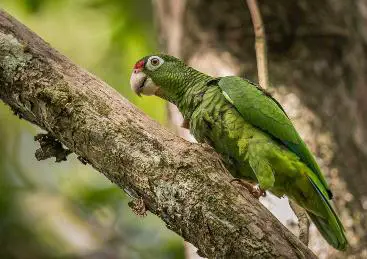
The primary diet of Puerto Rican Amazons is an herbivore, yet these creatures are also known as granivores and frugivores.
They feed on a variety of small-sized fruits (e.g., Genipa americana, aka jagua fruits), nuts (e.g., Chrysobalanus icaco nuts), as well as flowers, leaves, seeds (Dacryodes seeds, along with non-native plant species’ seeds), and bark, mainly from Pueraria montata (kudzu).
Usually, Puerto Rican Parrots forage for food in pairs. Sometimes, they have been observed feeding on corn crops. This food source has become available just recently due to agricultural changes that took place in the 20th century.
Behavior
Similarly to most parrots, Puerto Rican Amazons are diurnal creatures.
For most of the day, they are to spend their time foraging in the trees.
Puerto Rican Parrots fly in flocks. Formerly, these flocks used to be quite large.
However, during the breeding season, they become much more secretive and sedentary, making perfect use of their green plumage to stay hidden in the trees while nesting.
Also, breeding Puerto Rican Amazons are known to become aggressively territorial.
Reproduction

Puerto Rican amazons are strictly monogamous. They breed with the same partner for life.
However, in the case a female is injured, an adult breeding male may choose to abandon her in favor of selecting a healthier female mate. Also, Puerto Rican Parrots may change their mating partner if the partner dies.
Pairs often tend to participate in dance performances when selecting a mate, with both the male and the female getting engaged in the partial extension of the wings, well-coordinated bows, as well as the full expansion of the tail.
The breeding season for Puerto Rican Parrots starts in late February and continues up until early July.
These parrots breed in deep, large tree cavities and in cavities formed in the sides of small cliffs.
Recently, these parrots have started breeding in artificial cavities created out of wooden boxes.
Usually, the nest is located 7 – 15 meters above the ground. The clutch consists of 2 and up to 4 eggs. The incubation period takes between 24 and 28 days.
As males do rarely ever enter the nest, it is the females’ duty to perform the majority of the chicks’ rearing.
However, once the early stages of rearing the chicks have passed, males are to enter the nest with greater frequency. Meanwhile, females are to spend less time rearing the young chicks.
Chicks are known to remain with their parents for an unknown period of time after fledging, learning essential life skills from their parents.
Survival Threats & Conservation
THREATS
Puerto Rican amazons are listed under the Critically Endangered category on the IUCN Red List of Threatened Species.
Nowadays, there are only as few as about 1 – 49 sexually mature individuals remaining in the wild, based on the 2018 global assessment.
Being endemic to the island of Puerto Rico, these amazing Amazona species’ range is currently confined to a very small area in the northern portion of the island.
The major threats to the survival of the Puerto Rican Amazon include deforestation of habitat, over-hunting the population, wild bird trade, predation, as well as the consequences of climate change, including more frequent storms, hurricanes, and floods, and nonetheless, habitat shifting and alternation.
CONSERVATION
Back in the time, the IUCN considered the Puerto Rican Amazon the most endangered bird species on the planet.
However, thanks to a successful captive breeding and release program, there is a continuous population increase.
Between 2004 and 2007, 40 individuals were released into the wild. Ever since 2008, two natural nesting groups have been observed and recorded.
Puerto Rican Amazons are listed on CITES’ Appendix II. There is already a well-established action recovery plan, although there isn’t a systematic monitoring scheme.
Additionally, conservation sites have been identified over the entire area, and the species occurs in at least one protected area. Up-to-date, the remaining habitat is protected within the Caribbean National Forest
Also, there is some control and prevention over the invasive species.
Availability – Where to Get a Puerto Rican Amazon
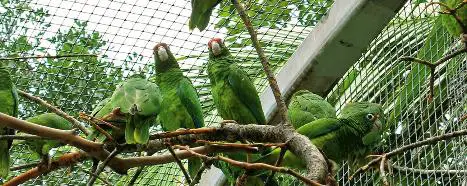
One cannot keep a Puerto Rican Amazon as a pet. These critically endangered parrots are not available for sale. They have been recently subjected to captive breeding programs.
Interesting Facts

1. Puerto Rican Amazons inhabiting the Luquillo rainforest were recorded obtaining their food from almost 60 species of plant!
2. Puerto Rican amazons are very vocal. They are known to produce a wide variety of squawks, whistles, and horn-like sounds. Similarly to many Amazona parrots, Puerto Rican amazons are capable of learning to speak human words.
During the flight, they make a bugling call. These parrots are renowned for their complex repertoire, which often tends to be individual to each bird.
3. Within their home range, Puerto Rican Amazons play a very special ecosystem role, as they are regarded as important seed dispersers.
4. At one point in the 1975s, the over-hunting of the Puerto Rican amazons led to the population becoming as low as 13 wild birds remaining in the wild. It is trapping and over-hunting that are considered the major causes of the species getting completely vanished from Mona Island and Vieques.
Fortunately, the estimated number of Puerto Rican amazons in the wild increased to 47 individuals in 1989. Tragically, when the northeast coast of Puerto Rico was struck by Hurricane Hugo on September 18, 1989, heavy casualties were inflicted on the remaining population, with only about 23 individuals remaining in the wild.
It wasn’t before 2004 that the wild population reached 30 – 35 individuals in number.
5. According to the British ornithologist David Lack, the Puerto Rican parrot is suggested to have had evolved from an Amazona species found in Hispaniola, namely A. ventralis (the Hispaniolan amazon).
Ever since David Lack shared his theory regarding the Puerto Rican amazon’s origin, his theory has been widely argued, because of David Lack having possibly omitted some elements during the evolution analysis, such as the similarities between the Puerto Rican Amazon and the Amazona parrot native to Jamaica, namely Amazona agilis, the black-billed Amazon.
Based on subsequent evolution studies, the results showed that neither the color patterns nor the size, are sufficient enough to assess evolutionary relationships properly. Even within members of the same species, patterns were found to change relatively easy.
Ultimately, the researchers concluded that Amazona vittata might actually share a common ancestor not with the Hispaniolan amazon (A. ventralis) but with the Jamaican black-billed Amazon (Amazona agilis).
Nowadays, thanks to recent cut-edge phylogenetic studies, researchers have turned back to David Lack’s theory regarding the evolution of the Puerto Rican amazon, as it was shown to be more closely related to the Cuban Amazon, as well as to the Hispaniolan amazon, rather than to the black-billed amazon in Jamaica.
How to Care for the Puerto Rican Amazon
The best way to care for the Puerto Rican Amazon is to spread awareness over the dire need for protecting this critically endangered species.
Using the power of social media, you can share these birds’ amazing yet tragic story, and make an impact by educating others on the consequences of human negligence, greed, and over-consumerism on the living nature.
Also, it is possible to donate time or money to protect this species from extinction by participating/ volunteering in various wildlife organizations engaged in the conservation of the Puerto Rican Amazon, among other species.
FAQ Section
What Do Puerto Rican Amazons Eat?
Puerto Rican amazons eat a great variety of leaves, flowers, seeds, bark, nectar, and fruits. They feed by foraging in the forest canopy.
Are Parrots Native to Puerto Rico?
Back in time, there used to be different parrots endemic to Puerto Rico. However, the Puerto Rican Amazon is the only remaining native parrot found on the island of Puerto Rico nowadays.
Are Puerto Rican Parrots Endangered with Extinction?
Yes, Puerto Rican Parrots are classified as Critically Endangered with extinction on the IUCN Red List. While the population trend remains unknown due to the lack of a systematic monitoring scheme, the recent success of captive breeding programs suggests that the population trend may be increasing.
Why Are Puerto Rican Amazons Endangered?
The major threats to endanger the future survival of Puerto Rican Amazons include habitat deforestation driven by human activity on the island of Puerto Rico, as well as illegal over-hunting and trapping. Other serious survival threats include non-native invasive species and diseases, and nonetheless, the ongoing consequences of climate change, namely habitat shifting and alternation, and a continuous increase in floods, hurricanes, and severe storms.
How Many Puerto Rican Amazon Parrots Are Left?
Currently, the number of Puerto Rican Amazon parrots that remain in the wild is estimated at between 1 – 49 sexually mature individuals, or about 34 – 40 individuals on an average.

